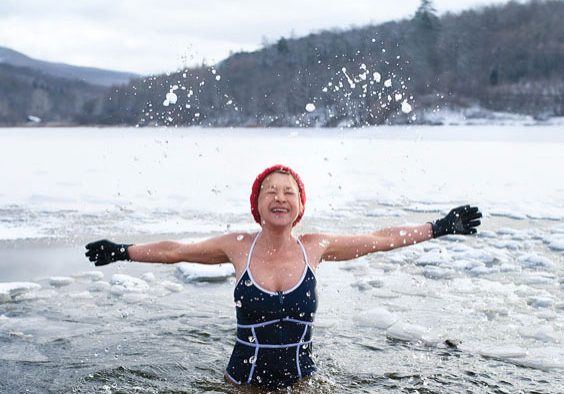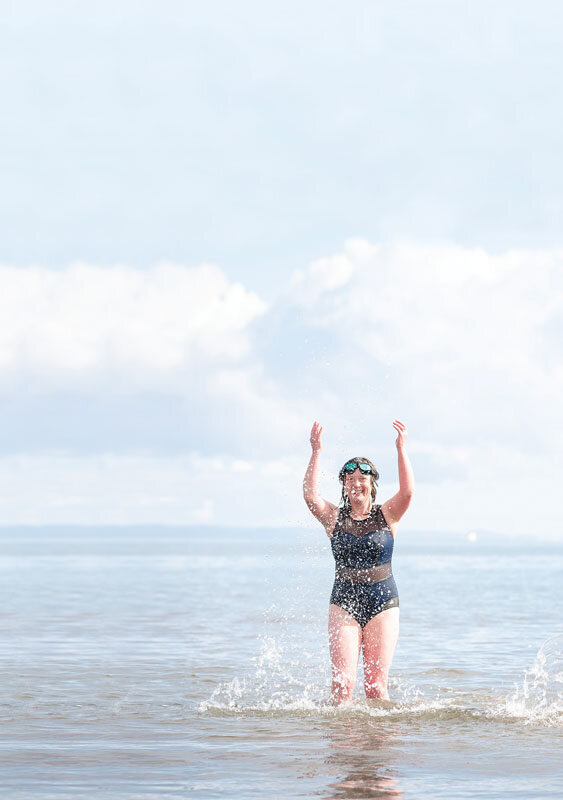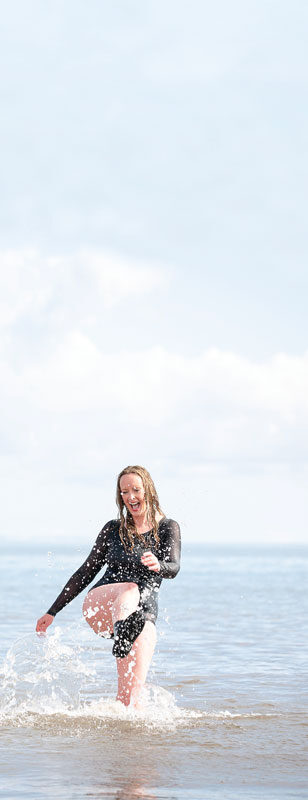
Take The Plunge
by Laura Storey
Research on this is in its infancy, but it has been shown that cold water swimming boosts the number of white blood cells
One blisteringly cold spring day early this year I took myself off for a walk up to Gaddings Dam. Often described as the highest beach in the UK, it is in fact a reservoir that is nestled in the peaks of Calderdale. As I reached the summit, a shriek travelled on the freezing wind and I realised there were women in the water. I hurried forward, wondering if they’d been thrown in by a particularly sharp gust. Then I realised the shrieks were laughter. The women were emerging for the water in wetsuits, wide smiles on their faces as they towelled off and got changed.
With pools being closed over lockdown, Brits have found other places to swim from hilltop reservoirs to waterfalls to lochs. Outdoor Swimmer reported that from searches for Wild Swimming had increased 94% in 2020 from the same period in 2019. It seems like everywhere you look people are getting obsessed with this new hobby.
According to authors and wild swimming enthusiasts Anna Deacon and Vicky Allan, there’s plenty of other benefits to wild swimming too! Here’s an extract from their book, The Art of Wild Swimming England & Wales.

Take the plunge!
1 IT’S EXHILARATING, often giddy, silly and wildly playful. Need we say more?
2 IT HAS ALL THOSE HEALTH AND MENTAL HEALTH BENEFITS that come with any form of exercise – swimming, whether indoors or outdoors, raises your heart rate, while taking impact stress off your body and improving muscle strength and cardiovascular fitness. But it has the added boon of being outside, and the mental wellbeing that brings.
3 COLD WATER SHOCK can be dangerous, but regular exposure to it can bring positives. It is a form of stress that exercises your body’s reaction to stress, triggering our fight or flight response through what’s called the sympathetic nervous system. That’s why you feel all that panic and confusion when the icy cold first hits.
Dr Mark Harper, a consultant anaesthetist who has researched cold water physiology, explained to us in Taking the Plunge that our bodies, these days, mostly experience low-level chronic stress, rather than intermittent big stress. ‘We used to be worried,’ he said, ‘about running from sabre-toothed tigers, now it’s running to get to a train on time. That low-level stress can be reduced. You can do it by adapting to cold water, which means you then cross-adapt to other stress.’
4 DUNK YOUR HEAD UNDER – or simply just your face (so you can keep your bobble hat on!) and you stimulate another part of your nervous system, resulting in mental and physical health benefits. What’s called the dive reflex , the splash of cold water on your face, stimulates your vagus nerve, activating your parasympathetic nervous system, slowing your heart, and putting your body into what’s called rest and digest mode. Mark Harper says, ‘When you put your face in cold water, you get this massive parasympathetic stimulation and that reduces inflammation, and that works through the vagal nerve.’ In effect, when you swim, you are exercising both these elements of your unconscious nervous system.
5 IT GIVES YOU A BIOCHEMICAL HAPPINESS FIX by triggering the release of endorphins. Of course, you can achieve this from going on a run or swimming indoors, but the great thing is that cold water swimming brings the endorphins on quicker, in even a brief dip.
6 MOST SWIMMERS TESTIFY TO SWIMMING HAVING IMPROVED THEIR MENTAL HEALTH. Research into this is still in its early days, but a 2018 case report showed that a 24-year-old woman with symptoms of severe depression and anxiety who did a weekly programme involving cold water swimming, found an improvement in mood after each swim and a sustained and gradual reduction in the symptoms of depression.
7 YOU BOOST YOUR IMMUNE SYSTEM. Research on this is in its infancy, but it has been shown that cold water swimming boosts the number of white blood cells – an element of the immune system that helps your body fight off infection – circulating in a person’s blood.
8 WHEN DONE WITH OTHERS IT’S ENORMOUSLY SOCIAL. There are parts of the swim community that are as much about getting together with other people and doing something daft or adventurous – about the cake and hot chocolate afterwards, the chat while bobbing in the ocean wearing a handknitted bobble hat – as getting the strokes in. Many studies now show that exercising in a social group is better for us, in general, than lone exercise.
9 IT MAY HELP STAVE OFF DEMENTIA. Research by scientists at the University of Cambridge found that long-term cold water swimmers had raised levels of the cold-shock protein called RBM3, which has been found to possibly slow the onset of dementia and even repair some of the damage in trials using mice, and which is produced in greater quantities during their hibernation.
10 IT MAY HELP PREVENT AND REDUCE THOSE CONDITIONS CHARACTERISED BY HIGH LEVELS OF INFLAMMATION, many of which are the key health problems of our times – inflammatory bowel disease, diabetes, Alzheimer’s, fibromyalgia, even heart disease. As Dr Mark Harper told us, ‘Cold water swimming appears to be one way of dealing with inflammation, which itself is at the root of a lot of health problems.’ A key mechanism via which it does this is the dive reflex, which stimulates the parasympathetic nervous system to send out chemical messengers that lower heart rate and reduce inflammation, and also others that turn on the pain inhibiting pathways in the brain.’
The safest and easiest way to get started is to go with someone who has experience with wild swimming, and if you don’t know anyone, join a group. They will not only know safe spots to swim and be able to show you the ropes, you can also get to know like-minded people and make new friends.
When you’re ready to take a dip, go slow. Remember, it’s Britain, so the water is more than likely going to be chilly.
Finally, buy a decent guide book – The Art of Wild Swimming is perfect to stash in your kit bag and has plenty more tips on staying safe.

OH, THE PLACES YOU’LL GO
MARY’S SHELL, CLEVELEYS what3words.com – melon.ferried.ledge
Mary’s Shell is a sculpture that has been located in the tidal area of the sea at Cleveleys and forms part of the Mythic Coast Art Trail. It is huge and when the tide comes in you get some pretty cool photos of it partly submerged. It is in the popular seaside town of Cleveleys, which is north of Blackpool. There is lots of parking and access into the water is from the promenade and down the steps. Again, you need to keep an eye on the tides as this area is tidal. This part of the coast isn’t sheltered and it can be very wavy and exciting, but when it is calm it’s all the better for exploring the shell.
MORECAMBE BAY what3words.com – sticky.stove.hurls
Affectionately known by local swimmers as ‘Mallows Bay’ as most people start swimming there after joining MALLOWS (the Morecambe and Lancaster Lancashire Open Water Swimmers) Facebook group. Just east of the Stone Jetty, this perfectly formed bay is overlooked by a large clock tower and the Eric Morecambe statue. Nearby there is a memorial to Commander Charles Gerald Fosberg OBE RN, who was a Master Mariner in the Second World War and a marathon swimmer who held the English Channel world record in 1957.
SANDSEND, NEAR WHITBY
what3words.com – dragonfly.improving.confident
Two miles north of Whitby, this village is a beautiful picture-postcard scene with some great little cafés for enjoying a post-swim cake and hot drink. If you are an experienced long distance swimmer you can swim from Whitby to Sandsend or vice versa depending on the tides. We usually enter the water just in front of Sandside café. It is perfect here, because even at high tide there is always some beach to get in and out onto. We’ve had post-swim campfires here and enjoyed a moonlit swim on a full moon. If you’re new to swimming at Sandsend, it is a good idea to familiarise yourself with the beach at low tide as there are rocks and wooden groynes that become hidden as the tide comes in.
HARDRAW FORCE, YORKSHIRE DALES
what3words.com – hurray.momentous.decorated
England’s highest single drop waterfall plunges a hundred feet and is mind-blowing in terms of its scale. You need to pay to visit – at the moment, adults are £4 and children £2.50 – but there is a café, toilets, visitor centre and nice path all the way in. It used to be owned by the pub next door, but a few years ago, it was bought by a private individual. There is parking, either right next to the tourist centre, where there’s room for about 20 cars. If not, you can park out on the road.
The Art of Wild Swimming England & Wales is published by Black & White Publishing and is out now for £14.99





